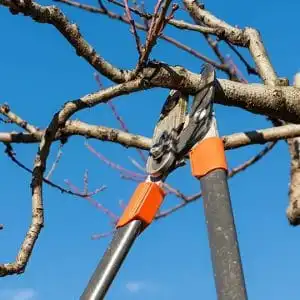The days are getting longer, the air is a little warmer, and the sound of birds can be heard again. It’s the time of year when our thoughts are turning eagerly to spring. Are you itching to get outside and do some spring cleaning in the yard? Many people think this is the right time to prune trees. But is it? If you’re ready to put your pruning skills into practice, we have 10 spring tree pruning tips to help you out.
The Why and When of Pruning
There are many reasons to prune trees. We take tools in hand to remove hazardous limbs, get rid of dead wood, or aesthetically shape a tree or shrub. Also, we do it for the tree’s health, like to rid it of diseased branches.
Pruning at any time of the year puts stress on a tree, but it heals better if the cuts are made when it’s not actively growing. The best time to prune most trees is while they are dormant, during late fall to early spring. Coincidentally, this is when the tree is bare of leaves, making it easier to inspect them for damage. Avoid pruning in late spring and early summer, when trees and shrubs are actively growing.
Planning to Prune?
Before you prune, do a little spring cleaning to prepare.
- Get rid of remaining holiday decorations, like light strings which could hamper growth.
- Take off protective wrapping used to cover young or weak trees against winter weather.
- Get rid of twigs, dead branches, leaves, and other debris that has congregated under and around trees in your yard.
- Finally, do some research and learn the natural shapes your trees and shrubs should achieve.
10 Spring Tree Pruning Tips
Okay, it’s time to grab your tools and cut. Here are 10 spring tree pruning tips to help you on your way.
- Prune a tree is while it is dormant. Some trees, like pines, can be pruned at any time. There are exceptions, though, like if the tree is a hazard.
- Flowering trees. Generally, prune spring flowering trees after they bloom. Trees and shrubs that flower later should be pruned in early spring while still dormant, and early enough to give them time to heal.
- Try to keep branches that have strong U-shaped angles and trim ones with weaker or narrow angles.
- It’s easier to manage younger trees, they heal quicker and adjust to change better.
- Never damage the branch collar. This is the point where a branch joins the trunk or another branch. By preserving the collar, and cutting at the same angle, the wound heals quicker and is less likely to get infected.
- Use the three-cut method to remove larger branches. First, make a cut on the underside of the branch one to two feet out on the branch to be removed. Saw about half way through the limb. Make another cut on top of the limb a couple inches farther out from the first cut. Finish by removing the stub.
- Don’t prune when it’s wet outside. Moisture encourages mold and bacteria growth.
- Use the right tools and keep them clean. For smaller branches under an inch in diameter, bypass hand pruners provide the cleanest cut. A bypass lopper works well on branches that are around an inch thick. For branches up to three inches, use a tri-edge folding saw.
- Never prune too much if you are thinning the crown. If you need to remove more than a quarter of the living crown, don’t do it all at once. Spread it out over a few years.
- When raising the crown to create a clear path for pedestrians, make sure the tree’s living crown is at least two-thirds of its height.
We’re Here to Help
Of course, safety comes first. Always cut with care and call in a professional for more difficult jobs. Call Free Spray Lawn Care today at 419-529-5296 with any questions or concerns about pruning your trees and shrubs, and let us help you get your yard ready for spring.



Comments (0)
Thanks for your comment!
Thanks for your feedback! Your comments have been successfully submitted! Please note, all comments require admin approval prior to display.
Error submitting comment!
There is a problem with your comment, please see below and try again.